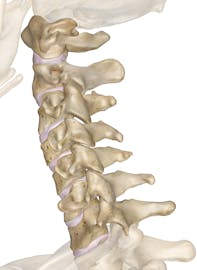The Cervical Vertebrae
Explore the anatomy and function of the cervical vertebrae with Innerbody's interactive 3D model.

The cervical vertebrae of the spine consist of seven bony rings that reside in the neck between the base of the skull and the thoracic vertebrae in the trunk. Among the vertebrae of the spinal column, the cervical vertebrae are the thinnest and most delicate bones. Yet, in spite of their size, the cervical vertebrae have the huge jobs of supporting the head, protecting the spinal cord, and providing mobility to the head and neck.
The cervical vertebrae are stacked along the length of the neck to form a continuous column between the skull and the chest. Each cervical vertebra is named by its position in order from superior (C1 or first cervical vertebra) to inferior (C7 or seventh cervical vertebra). The C1 vertebra, which holds up the skull, is named the atlas after the mythological titan Atlas who similarly held the Earth on his shoulders. Similar to the C1 vertebra, the C2 vertebra is named the axis as it provides the axis upon which the skull and atlas rotate when the head is moved side to side.
Each cervical vertebra consists of a thin ring of bone, or vertebral arch, surrounding the vertebral and transverse foramina. The vertebral foramen is a large opening in the center of the vertebra that provides space for the spinal cord and its meninges as they pass through the neck. Flanking the vertebral foramen on each side are the much smaller transverse foramina. The transverse foramina surround the vertebral arteries and veins, which, along with the carotid arteries and jugular veins, have the vital job of carrying blood to and from the brain.
Extending from the vertebral arch are several bony processes that are involved in muscle attachment and movement of the neck. The spinous process extends from the posterior end of the arch and serves as a connection point for the muscles that extend the neck, such as the trapezius and spinalis muscles. On the left and right lateral sides of each vertebra is a transverse process that forms the insertion point for the muscles of the erector spinae group that extend and flex the neck.
A thickened region of bone known as the body lies anterior to the vertebral foramen and forms the main bone mass in all vertebrae except for the atlas. The bodies strengthen the vertebrae and support most of the weight of the tissues of the head and neck. Intervertebral disks made of rubbery fibrocartilage lie between the vertebral bodies to provide slight flexibility to the neck. Lateral to the vertebral bodies are flattened facets that form joints with the neighboring vertebrae and skull, allowing movement among the vertebrae. The axis has a very distinct shape due to the presence of the odontoid process, a tooth-like prominence that extends from its body superiorly toward the axis. The odontoid process serves as the axis upon which the atlas rotates at the atlantoaxial joint.
Despite being some of the smallest and lightest bones in the axial skeleton, the cervical vertebrae perform many important functions that are critical to the survival of the body. Vital nerves and blood vessels passing through the neck are protected from mechanical damage by the bony arches of the cervical vertebrae. The cervical vertebrae also provide support to the head and neck, including supporting the muscles that move this region of the body. The muscles that attach to the vertebral processes provide posture to the head and neck throughout the day and have the greatest endurance of all of the body's muscles. Finally, the many joints formed between the skull and cervical vertebrae provide incredible flexibility that allows the head and neck to rotate, flex, and extend.









